When to Stop Mowing Your Lawn for Winter
When Should I Stop Cutting My Grass for the Year?
With winter just around the corner, you may be wondering when the best time to give your lawn its final cut of the year is.
Generally, this is best done between October and November. However, the challenge is timing this final mow just right so you don't accidentally damage your lawn's health.
Unfortunately, there’s no single date that works for everyone. The ideal timing varies depending on where you live. After all, the last mow in the south of England will almost always be later than in the north of Scotland, and every region in between follows its own pattern.
Mow too early and your grass may continue growing, leaving you with grass blades that are too long. This can cause them to mat down under snow or fallen debris, trapping moisture and encouraging disease. On the other hand, mow too late and your lawn may be left weakened and much more vulnerable to winter damage.
Here at Online Turf, we have been growing premium turf for over 20 years and we know how to get the timing just right to set your lawn up for success once spring returns.
It’s About Temperature, Not the Date
To get the last cut of the season right, don’t rely on a specific date but rather on temperature.
Due to the UK’s cooler climate and high rainfall, lawns are usually made from cool-season grasses. These grow best in temperatures between 10°C and 24°C, and growth effectively stops once temperatures fall consistently below 7°C.
During the colder months, gradually decrease the amount of mowing that you do as the grass growth begins to slow down. If you’re frequently mowing your lawn without giving the grass time to grow back and recover, you can scalp it, resulting in patchy and dead areas.
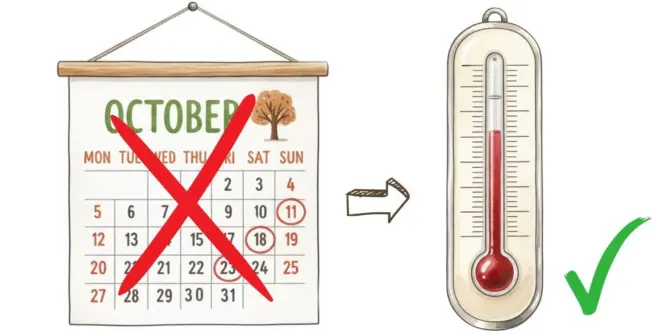
The final mow should align with the grass stopping its growth. Depending on where you are in the UK, this can be anytime from October to November. However, the warmer parts that experience milder winters may still need mowing even as late as early December! If your grass has already stopped growing completely, it is too late to mow, and you should wait until it starts growing again in the spring before mowing.
The Two Rules for the Final Winter Mow
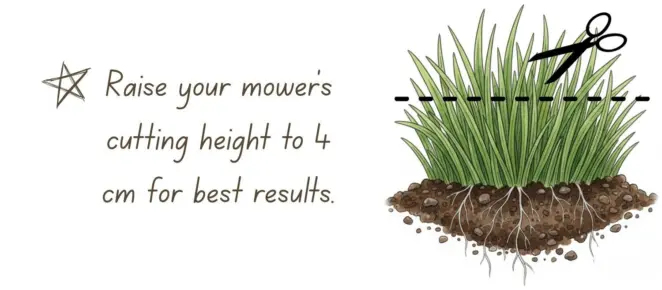
Rule 1: The Ideal Height
To keep your grass healthy and thriving through the winter, raise the cutting height of your mower slightly higher than you would for a summer cut. The RHS recommends around 4cm as an ideal height for the final mow.
Longer grass blades are more resilient to the cold as they give the plant more leaf area, allowing it to capture more sunlight. They also insulate the soil, reducing heat loss.
At the same time, at 4cm the grass isn’t going to be too long, so it will not mat under snow or fallen leaves. This reduces the risk of diseases developing.
Rule 2: The Condition
Avoid mowing a lawn when it's wet if possible as your mower may struggle to get a grip on the wet grass, potentially tearing its blades. This produces uneven results, weakens your lawn, and provides an open wound for fungal spores to enter and spread, making it highly susceptible to diseases.
On top of this, wet soil gets compacted very easily when walked on. If this happens, it will turn dense, preventing water from draining effectively, and likely become waterlogged, leaving your grass struggling to breathe. If you find yourself in a position where you simply must mow a lawn when it’s wet, make sure to check out our ‘Can You Cut Wet Grass?’ blog to learn how to minimise the negative impact on your grass.
Similarly, mowing frozen grass should also be avoided. According to Homebuilding & Renovation, ‘You should not cut frosty grass which will be brittle, as the water content in the grass blades freezes. Mowing at this time will cause untold damage to your lawn, potentially causing large areas to turn brown which can take a long time to recover’.
Instead, to make sure that your lawn gets the best care possible before going dormant, choose a mild, dry day to perform the final mow.
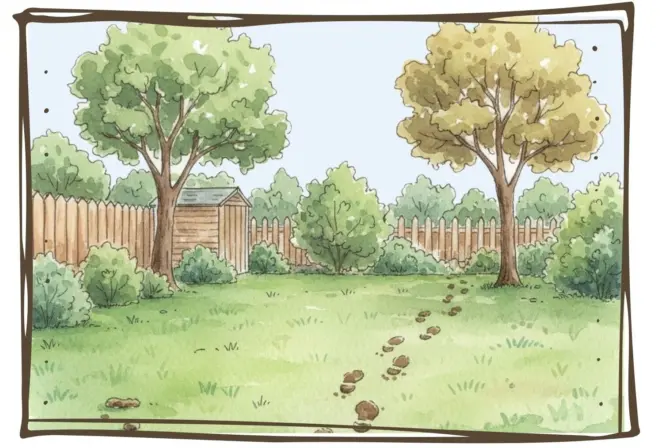
Why the Last Cut is Crucial for Winter Protection
Once grass stops growing completely, it enters a dormant state. This period of rest is crucial for your lawn as it helps it survive harsh winter conditions. However, it also leaves it more vulnerable to damage.
A correctly timed and performed final cut is a crucial step in providing your lawn with the winter protection it needs before this happens.
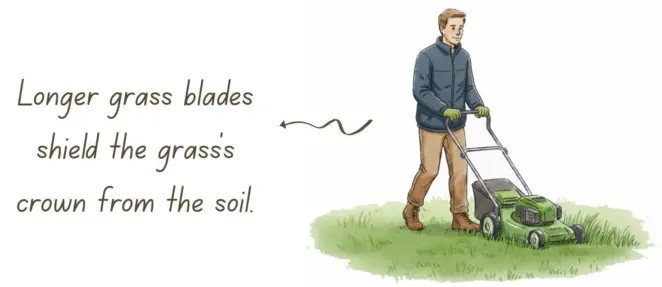
Protecting the Crown from Frost
When cut at the right height during the final mow, the longer grass blades play a crucial role in protecting your lawn’s crown - where the plant transfers energy and nutrients between the roots and blades.
By mowing your lawn at the right height and leaving the blades a little longer, you create a natural insulation layer. This shields the crown from frost, freezing temperatures, and harsh winter winds.
As a result, your lawn is less likely to suffer from winter damage and will bounce back to health faster once spring comes around again.
Discouraging Disease
Completing the last mow of the season is crucial for preventing diseases such as snow mould from affecting your turf. Grass that is not mowed correctly before dormancy can become matted under fallen leaves or snow, creating a damp, insulated environment with poor air circulation. This makes the conditions perfect for many fungal diseases to form, with snow mould being the most common at this time of year.
Snow mould, also known as fusarium, is one of the most damaging lawn diseases. It starts as small yellow circular patches that later turn brown. These patches can grow from around 5cm to 30cm in diameter and often merge together, affecting large areas. If not treated properly, the areas of your lawn that are affected may not recover.
The last cut of the year helps keep the grass at the right height, preventing matting and encouraging better airflow over winter. While diseases can still develop occasionally, the chances are significantly reduced when the lawn is prepared correctly.
To learn more about snow mould and other lawn diseases, including how to treat them, take a look at our ‘Common Lawn Diseases’ blog.

What to Do Immediately After the Last Cut (The Winter Prep Kit)
Once the last mow is done, it’s the perfect time to carry out a few final maintenance tasks.
Apply Winter Fertiliser
To offer further frost protection and disease resistance, make sure to feed your lawn with a fertiliser that’s specifically designed for the autumn or winter season and apply it before the ground freezes. Ideally, when the soil temperature is still above 7°C for best results. It should have high levels of potassium and low levels of nitrogen.
Applying a high-nitrogen feed this late in the season can cause weak, leggy growth that’s highly susceptible to frost damage. In contrast, a feed that’s high in potassium helps the plant build stronger cell walls, making it more resistant to cold and disease. It also allows the plant to focus on developing a stronger, deeper root system.
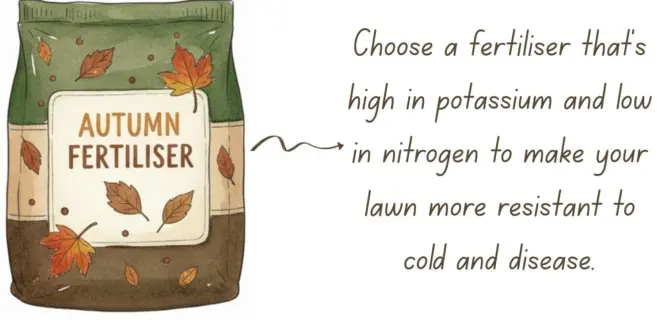
If possible, choose a feed that includes iron sulphate too. It will provide your turf with additional protection against harsh conditions and improve its colour without encouraging growth.

Clear All Debris
Invest in a rake and clear any debris, such as fallen leaves and twigs, on a weekly basis during the colder months. This is a great opportunity to add these to your compost pile or use them as mulch in the garden instead of throwing them away.
If left to collect on your lawn, the debris can smother your grass, blocking out sunlight and air, which can create yellow or dead patches and even kill the lawn in extreme cases.
A heavy layer of wet leaves can also trap moisture, encouraging fungal diseases and moss growth.
The Winter 'No-Walk' Rule
Once winter fully sets in, bringing heavy rain and occasional snow, the best thing you can do for your lawn is to introduce a ‘no-walk’ rule and simply leave it alone!
Frequent walking on wet or frozen grass can cause serious damage. Frozen blades become brittle and easily break underfoot, leading to brown patches in the areas that you walk on.
Meanwhile, compacted soil struggles to drain properly. This can cause your turf to become waterlogged and make it more vulnerable to winter stress. If waterlogged for a long period of time, it can even suffocate the roots and kill your grass.
If it’s not possible to stay off your lawn completely, consider installing stepping stones or paved paths to avoid stepping directly on the grass and soil.
Alternatively, if you have kids or pets who still want to play on it regularly, consider dividing your lawn into different zones and rotating their use. This will spread the wear more evenly and reduce soil compaction.
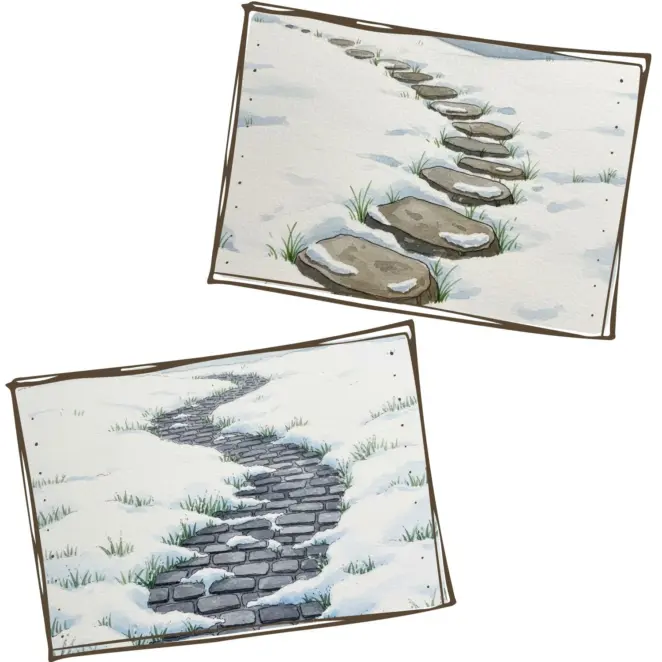
The ideal time to give your lawn its final cut varies depending on where you live. Once temperatures consistently fall below 7°C, grass stops growing, making it the perfect moment for that last mow before winter.
Cutting your lawn at the right time and height helps protect the crown and roots from the cold. It also reduces the risk of the grass becoming matted under snow or fallen debris, which can trap moisture and encourage disease.
After you have completed the final cut, make sure to follow up with essential winter maintenance: apply a suitable feed, clear away leaves and other debris, and then give your lawn a well-deserved rest by staying off it until spring. Remember: the effort you put in now will pay off when spring returns!
Do you want to keep your lawn looking its best all year round? Check out Online Turf’s Lawn Care Calendar today!
Should I cut my lawn in November?
This depends on temperature. If it’s consistently above 7°C, your lawn will still be actively growing and can be mowed safely.
When should I stop mowing for winter?
You should stop mowing once temperatures consistently drop below 7°C and your grass stops growing, allowing it to go dormant.
What’s the ideal winter grass height?
The ideal winter grass height is considered to be around 4 cm. This is long enough to keep the roots and crown of your turf insulated during winter, while not being so long that the blades mat easily under debris and snow.


